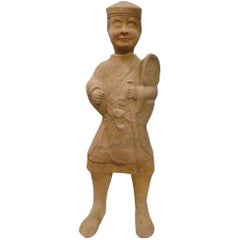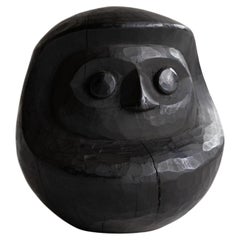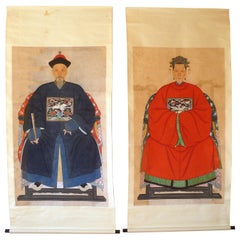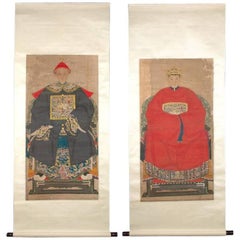Greenwich - More Asian Art, Objects and Furniture
4
to
1,166
1,048
4
4
4
2
2
2
2
1
1
4
4
3
1
Item Ships From: Greenwich
Japanese Buddhist Teaching Painting
Located in Greenwich, CT
Japanese Buddhist teaching painting, set of four paintings with 24 Buddhist stories with Japanese written characters in each story on one screen. Provenance: Purchased from Christie's South Kensington...
Category
1820s Japanese Edo Antique Greenwich - More Asian Art, Objects and Furniture
Materials
Paper
Fine Tang Dynasty Ox Cart Pottery Statue, TL Tested
Located in Greenwich, CT
An unusual pottery statue of ox and cart on plexi stand, Tang dynasty 618-907, comes with Oxford authentication TL test certificate. Oxford TL test sample ...
Category
15th Century and Earlier Chinese Tang Antique Greenwich - More Asian Art, Objects and Furniture
Materials
Terracotta
Pair of Qing Dynasty Architecture Carving Panels
Located in Greenwich, CT
Pair of Qing dynasty architecture carving panels, detail carvings with warriors riding horses.
Category
19th Century Chinese Qing Antique Greenwich - More Asian Art, Objects and Furniture
Materials
Wood
Han Dynasty Statue of Standing Guardian, Oxford TL Test Certificate
Located in Greenwich, CT
An elegant statue of standing guardian, benevolent facial expression, fine details, Han dynasty 206BC-220AD. Come with Oxford TL test certificate.
Category
15th Century and Earlier Chinese Han Antique Greenwich - More Asian Art, Objects and Furniture
Materials
Terracotta
Related Items
Chinoiserie Hand Painted Wallpaper Panels of Birds and Spring Blossom
Located in 10 Chater Road, HK
The fine pair of wallpaper panels hand painted in watercolor on rice paper, reproducing the 19th century Chinese export chinoiserie paintings ...
Category
21st Century and Contemporary Chinese Chinoiserie Greenwich - More Asian Art, Objects and Furniture
Materials
Paper
Japanese Antique Wood Carving Black Daruma 1860s-1920s / Wabi Sabi Sculpture
Located in Sammu-shi, Chiba
This is an old Japanese large wooden Daruma.
It is from the Meiji period (1860s-1920s).
It is made from a large cedar tree.
It is rustic and beautiful, with traces of hand-carving...
Category
Early 20th Century Japanese Meiji Greenwich - More Asian Art, Objects and Furniture
Materials
Cedar
No Reserve
H 8.67 in W 8.67 in D 8.27 in
Japanese Antique Wood Carving Elephant 1860s-1920s / Wabi Sabi Sculpture Object
Located in Sammu-shi, Chiba
This is a very old Japanese elephant wood carving.
This wood carving dates from the Meiji period (1860s-1920s).
We estimate the material to be cedar w...
Category
Early 20th Century Japanese Meiji Greenwich - More Asian Art, Objects and Furniture
Materials
Cedar
H 4.14 in W 9.45 in D 3.15 in
Pair of Chinoiserie Hand-Painted Paper Panels, Watercolor on Paper
Located in 10 Chater Road, HK
Original paintings, inspired by antique Chinese export wallpapers., from our studio.
An antiquing process is applied to the paintings for a distressed effect.
Category
21st Century and Contemporary Chinese Chinese Export Greenwich - More Asian Art, Objects and Furniture
Materials
Paper
Japanese Antique Wood Carving Heavenly God 1800s-1860s / Figurine Wabi Sabi
Located in Sammu-shi, Chiba
This is a very old Japanese wood carving of a god.
It is called "Tenjin.
Tenjin" is a general term for "a god who lives in heaven.
This wood carving dates from the Edo period (1...
Category
Late 19th Century Japanese Edo Antique Greenwich - More Asian Art, Objects and Furniture
Materials
Cedar
H 3.94 in W 4.73 in D 3.75 in
Japanese Antique Wood Carving Buddha 1700s-1800s / Figurine Object Wabi Sabi
Located in Sammu-shi, Chiba
This is a very old Japanese wooden Buddha.
It is a wood carving from the Edo period (1700s-1800s).
It appears to be carved out of cedar wood.
It is indescribably beautiful with dust...
Category
Late 18th Century Japanese Edo Antique Greenwich - More Asian Art, Objects and Furniture
Materials
Cedar
H 4.34 in W 1.38 in D 0.99 in
Japanese Antique Wood Carving Large Horse 1800s-1860s / Sculpture Wabisabi
Located in Sammu-shi, Chiba
Very old Japanese large wooden carving of a horse.
It dates from the Edo period (1800s-1860s).
It is made of cedar wood.
In Japan, there is ...
Category
Late 19th Century Japanese Edo Antique Greenwich - More Asian Art, Objects and Furniture
Materials
Cedar
H 32.68 in W 30.32 in D 11.42 in
Japanese Antique Wood Carving Fish 1860s-1900s / Mingei Figurine Object Wabisabi
Located in Sammu-shi, Chiba
This is a very old Japanese wood carving of a fish.
It is a wood carving from the Meiji period (1860s-1900s).
It is carved from cedar wood.
This wood carving is attached to a free h...
Category
Early 20th Century Japanese Meiji Greenwich - More Asian Art, Objects and Furniture
Materials
Cedar
H 7.49 in W 15.75 in D 4.34 in
A pair of 19th Century carved Foo temple dogs or Chinese guardian Lions
Located in London, GB
Chinese guardian lions, or imperial guardian lions, are a traditional Chinese architectural ornament. Typically made of stone, they are also known as stone lions or shishi (石獅; shíshī). They are known in colloquial English as lion dogs or foo dogs / fu dogs. The concept, which originated and became popular in Chinese Buddhism, features a pair of highly stylized lions—often one male with a ball and one female with a cub—which were thought to protect the building from harmful spiritual influences and harmful people that might be a threat. Used in imperial Chinese palaces and tombs, the lions subsequently spread to other parts of Asia including Japan (see komainu), Korea, Philippines, Tibet, Thailand, Myanmar, Vietnam, Sri Lanka, Nepal, Cambodia, Laos, and Malaysia.
There has been extensive interaction between Chinese mythology and Confucianism, Taoism, and Buddhism. Elements of pre-Han dynasty mythology such as those in Classic of Mountains and Seas were adapted into these belief systems as they developed (in the case of Taoism), or were assimilated into Chinese culture (in the case of Buddhism). Elements from the teachings and beliefs of these systems became incorporated into Chinese mythology. For example, the Taoist belief of a spiritual Paradise became incorporated into mythology as the place where immortals and deities used to dwell. Sometimes mythological and religious ideas have become widespread across China's many regions and diverse ethnic societies. In other cases, beliefs are more limited to certain social groups, for example, the veneration of white stones by the Qiang. One mythological theme that has a long history and many variations involves a shamanic world view, for example in the cases of Mongolian shamanism among the Mongols, Hmong shamanism among the Miao people, and the shamanic beliefs of the Qing dynasty from 1643 to 1912, derived from the Manchus. Politically, mythology was often used to legitimize the dynasties of China, with the founding house of a dynasty claiming a divine descent.
Mythology and philosophy.
Further information: Chinese philosophy
True mythology is distinguished from philosophical treatises and theories. Elaborations on the Wu Xing are not really part of mythology, although belief in five elements could appear. The Hundred Schools of Thought is a phrase suggesting the diversity of philosophical thought that developed during the Warring States of China. Then, and subsequently, philosophical movements had a complicated relationship with mythology. However, as far as they influence or are influenced by mythology, divides the philosophical camps into two rough halves, a Liberal group and a Conservative group. The liberal group being associated with the idea of individuality and change, for example as seen in the mythology of divination in China, such as the mythology of the dragon horse that delivered the eight bagua diagrams to Fu Xi, and methods of individual empowerment as seen in the Yi Jing (Book of Changes). The Liberal tendency is towards individual freedom, Daoism, and Nature. The relationship of the Conservative philosophies to mythology is seen in the legendary Nine Tripod Cauldrons, mythology about the emperors and central bureaucratic governance, Confucianism, written histories, ceremonial observances, subordination of the individual to the social groups of family and state, and a fixation on stability and enduring institutions. The distinction between the Liberal and Conservative is very general, but important in Chinese thought. Contradictions can be found in the details, however these are often traditional, such as the embrace by Confucius of the philosophical aspects of the Yi Jing, and the back-and-forth about the Mandate of Heaven wherein one dynasty ends and another begins based according to accounts (some of heavily mythological) where the Way of Heaven results in change, but then a new ethical stable dynasty becomes established. Examples of this include the stories of Yi Yin, Tang of Shang and Jie of Xia or the similar fantastic stories around Duke of Zhou and King Zhou of Shang.
Mythology exists in relationship with other aspects of society and culture, such as ritual. Various rituals are explained by mythology. For example, the ritual burning of mortuary banknotes (Hell Money), lighting fireworks, and so on.
A good example of the relationship of Chinese mythology and ritual is the Yubu, also known as the Steps or Paces of Yu. During the course of his activities in controlling the Great Flood, Yu was supposed to have so fatigued himself that he lost all the hair from his legs and developed a serious limp. Daoist practitioners sometimes incorporate a curiously choreographed pedal locomotion into various rituals. Mythology and practice, one explains the other: in these rituals, the sacred time of Yu merges with the sacral practice of the present.
Various ideas about the nature of the earth, the universe, and their relationship to each other have historically existed as either a background or a focus of mythologies. One typical view is of a square earth separated from a round sky by sky pillars (mountains, trees, or undefined). Above the sky is the realm of Heaven, often viewed of as a vast area, with many inhabitants. Often the heavenly inhabitants are thought to be of an "as above so below" nature, their lives and social arrangements being parallel to those on earth, with a hierarchical government run by a supreme emperor, many palaces and lesser dwellings, a vast bureaucracy of many functions, clerks, guards, and servants. Below was a vast under ground land, also known as Diyu, Yellow Springs, Hell, and other terms. As time progressed, the idea of an underground land in which the souls of the departed were punished for their misdeeds during life became explicit, related to developments in Daoism and Buddhism. The underground world also came to be conceived of as inhabited by a vast bureaucracy, with kings, judges, torturers, conductors of souls, minor bureaucrats, recording secretaries, similar to the structure of society in the Middle Kingdom (earthly China).
Chinese temple Dogs...
Category
1860s Chinese Chinese Export Antique Greenwich - More Asian Art, Objects and Furniture
Materials
Hardwood
H 11.42 in W 20.48 in D 7.49 in
Qing Dynasty Giltwood and Red Painted Floral Architectural Panel in Frame
Located in Yonkers, NY
A late Qing Dynasty period giltwood architectural panel on red ground, with floral motifs, set in new frame. Delve into the rich tapestry of the late Qing Dynasty period with this gi...
Category
Early 20th Century Chinese Qing Greenwich - More Asian Art, Objects and Furniture
Materials
Wood, Giltwood
Japanese Antique Wood Carving Turtle 1800s-1860s/Folk Crafts Object Mingei
Located in Sammu-shi, Chiba
This is a very old Japanese carved wooden turtle.
This item is from the Edo period (1800s-1860s).
It is made of cedar wood.
Very rare item.
Turtles have...
Category
Late 19th Century Japanese Edo Antique Greenwich - More Asian Art, Objects and Furniture
Materials
Cedar
No Reserve
H 3.35 in W 7.49 in D 12.6 in
Japanese Antique 'KOMAINU' Shrine Guardian Dog Statues 1600s-1700s / Wabisabi
Located in Sammu-shi, Chiba
This is a very old Japanese "KOMAINU".
It is an item from the early Edo period (1600s-1700s).
It is carved from cedar wood.
A-Un," or "A-Un," is the Japanese word for "guardian dog....
Category
Late 17th Century Japanese Edo Antique Greenwich - More Asian Art, Objects and Furniture
Materials
Cedar
H 14.18 in W 7.29 in D 9.45 in
Previously Available Items
Pair of Chinese Qing Dynasty Ancestor Portrait Scroll Paintings
Located in Greenwich, CT
Pair of Chinese Qing dynasty imperial office and wife ancestor portrait paintings.
Very nice detail and fine paintings.
Overall size: Each painti...
Category
19th Century Chinese Qing Antique Greenwich - More Asian Art, Objects and Furniture
Materials
Paper
Pair of Hanging Scrolls Brushing Painting of Qing Dynasty Imperial Noble Couple
Located in Greenwich, CT
A pair of fine hanging scrolls, brush painting of Qing dynasty imperial noble couple wearing formal court robes sitting on chairs.
Overall size ...
Category
1890s Chinese Qing Antique Greenwich - More Asian Art, Objects and Furniture
Materials
Paper
H 60 in W 25 in D 0.25 in
Fine Jumu Asian Display and Storage Chest
Located in Greenwich, CT
Fine jumu Asian display and storage chest with pair of doors and two drawers. We carry fine quality furniture with elegant finished and has been appear...
Category
Late 19th Century Chinese Ming Antique Greenwich - More Asian Art, Objects and Furniture
Materials
Wood
Refined Pottery Statue of Standing Camel with a Mongolian Rider, TL Tested
Located in Greenwich, CT
A very fine and superbly modeled pottery statue of standing camel with a mongolian rider, early Tang dynasty 618-907, comes with Oxford authentication TL test certificate. Oxford TL ...
Category
15th Century and Earlier Chinese Tang Antique Greenwich - More Asian Art, Objects and Furniture
Materials
Terracotta
H 21.5 in W 16 in D 6.5 in
A Superb and Playful Tang Dynasty Pottery Statue of Lady Polo Player
Located in Greenwich, CT
A superb and playful pottery statue of lady polo player with original pigment, Tang Dynasty 618-907, comes with Oxford authentication TL test certificat...
Category
15th Century and Earlier Chinese Tang Antique Greenwich - More Asian Art, Objects and Furniture
Materials
Terracotta
Important Chinese Qing Dynasty Imperial Prince / Pacification Hero Portrait
Located in Greenwich, CT
Very unusual, rare and important early Chinese Qing Dynasty Imperial Prince's portrait or Nation Pacification Hero crowned by emperor portrait, 1...
Category
18th Century and Earlier Chinese Antique Greenwich - More Asian Art, Objects and Furniture
Recently Viewed
View AllMore Ways To Browse
Chinese Jade Bonsai Tree
Antique Japanese Futon Cabinet
Antique Jars Philippines
Antique Wooden Farm Tools
Japanese Musha Ningyo
Elk Ivory
Indonesian Gong
Kuruma Tansu
Musha Ningyo
Raw Jadeite
Asian Rattan Hat
Vintage Jade Bonsai
Antique Tibetan Prayer Box
Antique Chinese Bronze Teapot
Chinese Wedding Lanterns
Set Of 4 Bell Lanterns
Burmese Hintha Bird
Cloisonne Plate Cranes







